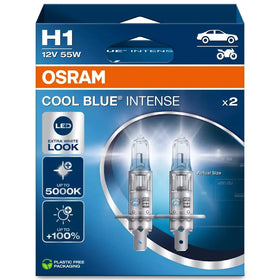Sort + Filter
H1 halogen bulbs

H1 halogen bulbs are a widely used type of single filament automotive light bulb known for their efficient performance and reliability. These bulbs are commonly used in a variety of vehicle lighting applications due to their bright light output and straightforward design. Here is a detailed overview of their characteristics, applications, advantages, and other relevant information:
Key Characteristics
-
Single Filament Design:
- H1 bulbs have a single filament, which makes them suitable for specific functions like high beam, low beam, or fog lights.
-
Standardization:
- H1 bulbs are standardized under ECE Regulation 37 in Europe and other international standards, ensuring compatibility across different vehicle makes and models.
-
Brightness and Light Output:
- H1 bulbs typically produce around 1,550 lumens, providing bright and focused illumination suitable for various driving conditions.
-
Wattage and Voltage:
- Standard H1 bulbs operate at 55 watts and are designed for a 12-volt electrical system, common in most vehicles.
Applications
-
Headlights:
- H1 bulbs are frequently used in headlight assemblies, serving either as low beam or high beam lights, depending on the vehicle's design.
-
Fog Lights:
- They are also commonly used in fog light assemblies to improve visibility in poor weather conditions.
-
Auxiliary Lights:
- Some vehicles use H1 bulbs in additional auxiliary lights to provide extra illumination.
Advantages
-
Brightness and Beam Quality:
- H1 bulbs offer a bright and concentrated beam of light, which enhances nighttime visibility and overall driving safety.
-
Ease of Replacement:
- These bulbs are designed for easy installation, often involving a straightforward plug-and-play process.
-
Cost-Effective:
- Halogen bulbs, including H1, are generally more affordable than HID or LED options, making them a practical choice for many drivers.
-
Wide Availability:
- H1 bulbs are readily available in various brands and models, making it easy to find replacements when needed.
Installation
-
Compatibility:
- It is essential to check the vehicle’s manual to ensure compatibility with H1 bulbs. Many vehicles are designed specifically to use H1 bulbs for their headlight or fog light assemblies.
-
Installation Process:
- Installation typically involves accessing the headlight or fog light assembly, removing the old bulb, and inserting the new H1 bulb. Care should be taken not to touch the glass part of the bulb with bare hands, as oils from the skin can shorten the bulb’s lifespan.
Considerations
-
Heat Output:
- H1 bulbs generate heat, so proper ventilation in the headlight or fog light housing is necessary to prevent overheating and ensure the longevity of the bulb.
-
Lifespan:
- While halogen bulbs generally have a shorter lifespan compared to LED or HID bulbs, H1 bulbs are reliable and typically last between 500 to 1,000 hours of use.
-
Performance in Adverse Conditions:
- Halogen bulbs, including H1, can sometimes be less effective in adverse weather conditions like heavy rain or fog compared to some HID and LED options.
Popular Brands
-
Philips:
- Known for high-quality automotive lighting solutions, Philips offers a range of H1 bulbs with enhanced brightness and durability.
-
Osram:
- Another leading brand in automotive lighting, Osram provides H1 bulbs known for their reliability and performance.
Regulatory Standards
-
ECE R37:
- In Europe, H1 bulbs must comply with the ECE R37 standard, which ensures they meet specific performance and safety criteria.
-
DOT (Department of Transportation):
- In the United States, H1 bulbs must meet DOT standards to be legally used on public roads.
In summary, H1 halogen bulbs are a popular choice for automotive lighting due to their brightness, ease of installation, and cost-effectiveness. They are widely used in headlight and fog light applications, providing reliable performance and improving nighttime driving visibility.






